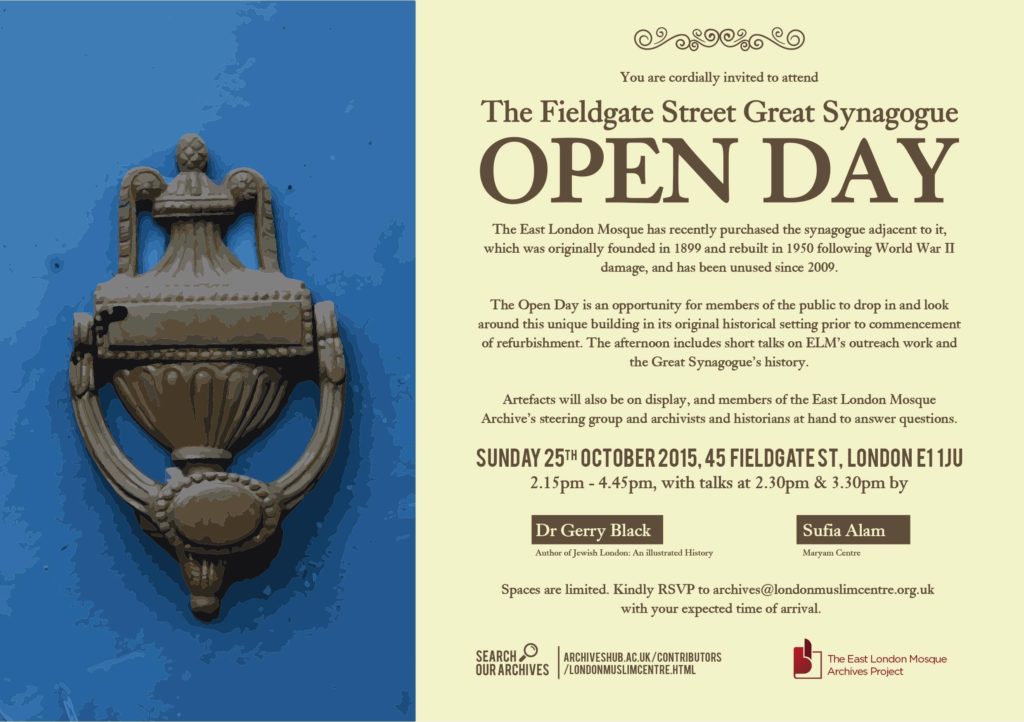
The air was a bit musty but the welcome warm and friendly. Salaam Blogger had often passed the Fieldgate Street Great Synagogue doorways, wondering what it was like inside. The opportunity arose on a Sunday afternoon (25th October 2015), at an Open Day organised by the East London Mosque, which surrounds the place on three sides!
The synagogue has two entrances, a main hall downstairs and a floor upstairs for women worshippers. On entering via the righthand door, along the corridor and on top of the doorway to the main hall, there is a prayer in Hebrew,
“How lovely are your tents, O Jacob, your dwelling places, O Israel!“.
There are small vestibules before the prayer rooms, for symbolic cleansing prior to entry.
The premises had been recently acquired by ELM trustees after a community-based funding appeal, and the aim of the Open Day was to provide ‘an opportunity for members of the public to drop in and look around a unique building in its original historical setting prior to refurbishment’. The event was attended by many former worshippers of the synagogue, some with their children and grandchildren. It was a friendly family occasion with short presentations by trustee Dr Muhammad Abdul Bari, and Sufia Alam, a mosque project manager at the mosque’s Maryam Centre, on the record of cordial relations with neighbours of other faiths over the decades. The programme included talks by Dr Gerry Black, a legendary figure within the British Jewish community, and also Mr Nat Roosk, who had served as vice-president of the Synagogue, until it ceased to be used as a place of worship in 2009. The local Jewish community had dwindled over the years, with only a handful present towards the end. Materials from the East London Mosque archive collection dating from 1910 were on display, as well as artefacts of the Synagogue, which was built in 1899 (and partially rebuilt after World War II damage).
In his welcome, Dr. Bari provided examples of good inter-faith relations that have persisted even though ‘there were many nay-sayers seeking to dwell on disharmony’. Sufia Alam hoped that events such as these would continue, carrying on the traditions of interfaith work set by former mosque trustees such as the late Suleman Jetha. She referred to his invitation to the Finchley Synagogue in the 1960s to visit the East London Mosque, and the letter of solidarity received from the Jewish Youth Assembly during the skinhead attacks a decade later.
Dr. Black described his childhood in Bow and the struggle which many in the Jewish community faced to overcome social hardships and poverty, by focussing on education. Dr. Black was born in 1928 and served in the army from 1946-1948, with a posting at Belsen. He then studied law at the LSE and completed a PhD on Health and Medical Care of the Jewish Poor in the East End of London, 1880-1939. In addition to his books on Jewish history, he has served as president of the Jewish Historical Society and trustee of the Jewish Museum. Mr. Roosk,who was raised in Stepney Green, spoke about his dealings with the East London Mosque Trust while the mosque was being constructed adjascent to the Synagogue in the 1980s, and the way difficulties were amicably resolved. Later, the Trust was to provide financial assistance for repair of the Synagogue roof. There was some gentle sparring between the two when the ‘boys from Bow’ would vie with his group in Stepney. When raising funds for the Synagogue purchase in July 2015, the East London Mosque Trustees launched a Ramadan appeal. The community response was overwhelming – raising over £1.1m (mainly qard hasana it is said, in a 14-hour fundraiser on the Bangla Channel S). The mosque trustees have not announced their plans for the re-use of the former Synagogue site.
